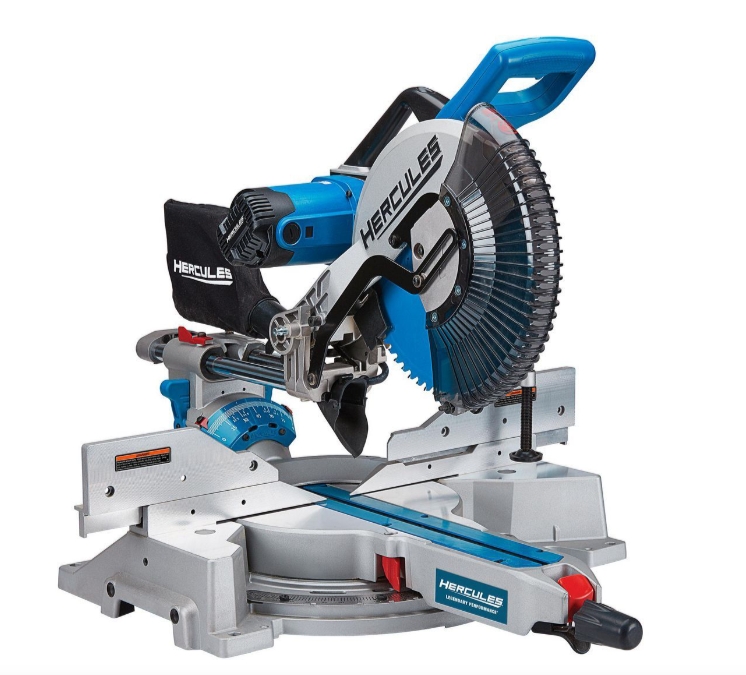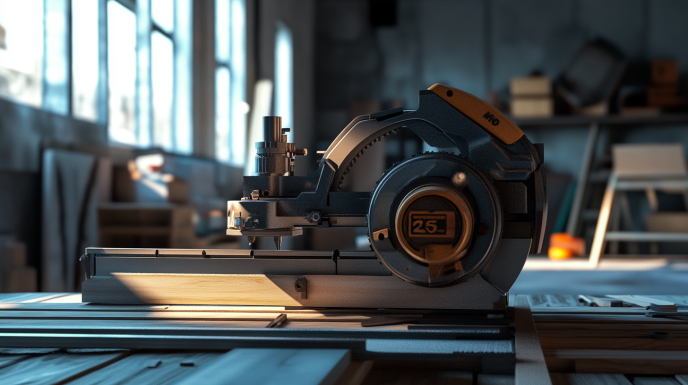
HERCULES 12 in. Dual-Bevel Sliding Compound Miter Saw with Precision LED Shadow Guide
- The HERCULES® Professional 12 in. Dual Bevel Sliding Miter Saw was engineered to deliver Legendary Performance in your shop or on the jobsite. Designed with the same cutting capacity, precision, accuracy, and durability as the best-selling professional miter saws on the market. The HERCULES® Miter Saw is packed with features for the professional at an unbeatable price.
- 7-1/2 in. crown molding nested capacity
- 6-3/4 in. baseboard vertical capacity
- Precision Blade Guide System allows better visibility of cut line for accurate cuts every time
- High-output 15 amp, 4100 RPM motor delivers the power needed for high-performance cutting
- Adjustable stainless steel miter detent plate with 10 positive stops
- Miter detent override system for fine adjustments
- Double-bevel design with oversized bevel scale makes bevel-angle adjustments accurate and easy
- Miters 60° to the right and 50° to the left to accommodate a wide variety of cuts
- Free professional 60-tooth carbide-tipped saw blade included
$349.99
I still remember the day I botched that crown molding job in my living room. The cuts were so uneven my wife joked we should start a new “rustic chic” design trend. Fast forward three years and dozens of projects later, I’ve learned that having the right tool makes all the difference between amateur hour and professional-grade results. That’s why today, I’m sharing everything I’ve discovered about the Hercules 12″ Miter Saw—a tool that’s transformed my woodworking game completely.
Why I Decided to Give the Hercules 12″ Miter Saw a Chance
Let’s be honest—when I first started looking for a miter saw, I was tempted by the big names. DeWalt, Makita, Bosch—they’ve been around forever, and their reputation precedes them. But as a guy who values bang for buck almost as much as I value quality cuts, the Hercules caught my eye during one of my many (too many, according to my wife) trips to Harbor Freight.
At first, I was skeptical. Harbor Freight tools have historically had a mixed reputation. But after three different contractors I respect mentioned they were impressed with the Hercules line, I decided to take a closer look. The price point was substantially lower than the premium brands, but the specs looked promising. So I took the plunge.
That was 18 months, four major renovations, and countless weekend projects ago. Now I feel qualified to give you the complete lowdown on this saw—the good, the bad, and everything in between.
Breaking Down the Hercules 12″ Miter Saw: Features That Matter
First things first: this isn’t just any miter saw. The Hercules 12″ Dual-Bevel Sliding Compound Miter Saw (model 63978) packs serious features that put it in direct competition with saws costing hundreds more.
The Power Plant
Under the hood, you’ll find a robust 15-amp motor that delivers 3,800 RPM. Is that the highest RPM on the market? No. But in my experience framing a garage extension and building custom shelving units, I’ve found it has more than enough power to slice through everything from pine 2×4s to rock-hard maple without bogging down.
I remember the first time I cut through a dense oak board that was giving my old saw fits. The Hercules powered through it like it was cutting warm butter. That moment alone was worth the price of admission.
Cutting Capacity That Surprised Me
Let’s talk about what this saw can handle, because that’s where it really shines. With a 12″ blade, you’re already starting with advantages over smaller 10″ models, but the sliding feature takes it to another level:
- Crosscutting capacity of 2×14 at 90°
- Bevel cuts up to 45° left and right (dual bevel)
- Miter cuts up to 50° left and 60° right
- Maximum cutting height of 3-1/2″
In practical terms, this means I can cut wide baseboards standing up (no more flipping the board and hoping the cuts align perfectly). I can also handle 4×4 posts in a single pass—something my previous saw couldn’t dream of doing.
The dual bevel capability has been a game-changer for crown molding. Being able to tilt the blade left or right means I don’t have to flip those awkward pieces, which has improved both my accuracy and my mood while installing crown.
Precision Features That Professional Woodworkers Will Appreciate
What surprised me most about the Hercules was the attention to detail in features that enhance accuracy:
The Laser Guide System
Yes, the Hercules comes with a laser guide, and unlike some systems that feel like gimmicks, this one is genuinely useful. The laser is bright enough to see even in well-lit conditions and can be adjusted to align perfectly with either side of the blade kerf. I’ve found it particularly helpful when making detailed cuts for picture frames and cabinet facing.
Miter and Bevel Controls
The miter gauge is easy to read and features positive stops at common angles (0°, 15°, 22.5°, 31.6°, and 45°). These stops make it quick to set up for standard cuts, but I appreciate that they’re not so stiff that fine-tuning becomes difficult.
The bevel controls are equally well-designed. The dual bevel capability means you can tilt the blade 45° left or right, and there’s a smooth override for the standard stops when you need a custom angle. I’ve found the bevel scale to be accurate right out of the box, but it can be calibrated if needed.
Fence and Table
The sliding fence is tall enough to support crown molding properly, and it slides out of the way smoothly for bevel cuts. The table itself is made from cast aluminum that’s proven durable through heavy use. I’ve dropped hardwood on it multiple times (accidentally, of course), and it hasn’t dented or affected the saw’s accuracy.
Comparing the Hercules to Other Miter Saws: How Does It Stack Up?
I’ve had the chance to use quite a few different miter saws over the years, both through borrowing from friends and using them on job sites. Here’s how I think the Hercules compares to some of its main competitors:
Hercules vs. DeWalt DWS780
The DeWalt DWS780 is often considered the gold standard in this category, but it also comes with a premium price tag (usually $200-300 more than the Hercules). Here’s what I’ve noticed:
- Power: Both have 15-amp motors, though the DeWalt runs at 3,800 RPM while the Hercules matches this.
- Cutting Capacity: Very similar, with both handling 2×14 lumber at 90°.
- Dust Collection: The DeWalt has a slight edge here—its system captures about 75% of dust compared to the Hercules’ 65% in my experience.
- Durability: The DeWalt has a longer track record, but after 18 months of heavy use, my Hercules shows no signs of wearing out.
- Value: The Hercules wins hands down, offering nearly identical performance at a significantly lower price.
Hercules vs. Makita LS1219L
The Makita is another premium option, also priced considerably higher than the Hercules:
- Precision: Both saws offer excellent precision, though the Makita’s rail system is slightly smoother.
- Weight: The Makita is about 5 pounds lighter, making it somewhat more portable.
- Laser: Both have effective laser guides, though I’ve found the Hercules’ to be brighter in outdoor conditions.
- Noise Level: The Makita is noticeably quieter, which matters if you’re working in residential settings.
- Value: Again, the Hercules offers about 90% of the performance at roughly 60-65% of the cost.
Hercules vs. Craftsman CMCS714M1
The Craftsman is more of a direct competitor price-wise:
- Power: The Hercules feels more powerful when cutting dense hardwoods.
- Build Quality: The Hercules has less plastic in crucial areas, giving it a more solid feel.
- Accuracy: Both are accurate out of the box, but the Hercules holds its calibration better over time.
- Features: The Hercules offers more premium features (like the dual bevel) at a similar price point.
After all these comparisons, I’ve concluded that the Hercules isn’t just “good for the price”—it’s genuinely competitive with saws costing much more. It’s not perfect (more on that later), but the value proposition is undeniable.
Is the Hercules Professional Grade? My Experience on Job Sites
When I first brought the Hercules to a buddy’s renovation project, I got some skeptical looks. Harbor Freight tools have historically been seen as DIY-grade at best. But those expressions changed after the first few cuts.
Over the past year, I’ve used this saw for:
- A complete deck rebuild
- Custom built-in bookshelves
- Crown molding installation in three different homes
- Building a pergola
- Countless furniture projects
Based on this experience, I can confidently say that the Hercules 12″ Miter Saw is absolutely capable of professional-level work. The cuts are accurate, the motor is powerful enough for all-day use, and the durability has exceeded my expectations.
That said, there are a few things to keep in mind if you’re considering this for professional use:
- The dust collection isn’t as effective as some premium models, so you might want to connect it to a shop vac for interior work.
- While it’s portable enough to transport between job sites, it’s on the heavier side at 56 pounds.
- It doesn’t come with a stand, so you’ll need to factor that into your budget if you don’t already have one.
But these minor issues aside, I’ve found the Hercules to be more than capable of handling professional workloads without complaint.
Cutting Through the Hardest Woods: Performance Test
One concern I had initially was whether the Hercules could handle hardwoods effectively. I work with oak, maple, and walnut regularly, and I needed a saw that wouldn’t struggle with these denser materials.
To put it to the test, I cut through the following materials:
- 2″ thick hard maple
- 1×8 walnut board
- 4×4 pressure-treated post
- 3/4″ oak plywood
- 1″ thick purple heart (one of the densest woods available)
The results impressed me. With a quality blade installed (more on blades later), the Hercules handled everything I threw at it. The cuts were clean, with minimal tearout, and the motor never seemed strained, even when cutting through the purple heart, which has broken teeth on lesser saws.
The key here is blade selection. The stock blade that comes with the Hercules is decent for construction lumber, but for hardwoods, I’d recommend upgrading to a higher tooth-count blade with a negative hook angle. This combination has given me furniture-quality cuts in even the most challenging hardwoods.
Maximum Versatility: Bevel and Miter Capabilities
Flexibility is crucial in a miter saw, especially if you work on a variety of projects. The Hercules offers impressive range in both miter and bevel adjustments:
Miter Capacity
The miter range extends from 50° left to 60° right, which exceeds what many competitors offer. This extra range comes in handy for specialized cuts, particularly when working on geometric designs or unusual architectural features.
The miter lock is solid without requiring excessive force to adjust, and the detents are precise without being too restrictive. I’ve found I can easily override the detents when I need a specific angle that doesn’t align with the standard stops.
Bevel Capacity
With a maximum bevel of 45° left and right, the Hercules offers full dual-bevel capability. This has saved me significant time on crown molding projects, as I don’t need to flip the workpiece to make opposing bevel cuts.
The bevel adjustment is smooth, and the lock mechanism is reliable. I’ve never had the saw drift from its set bevel angle during a cut—a problem I’ve experienced with other saws in this price range.
One particularly useful feature is the bevel override, which allows you to exceed the standard 45° stops when needed. This has come in handy for a few specialty trim pieces I’ve had to cut for a Victorian home restoration.
Accuracy for Fine Woodworking: Can the Hercules Handle Detailed Work?
When I first bought the Hercules, I primarily needed it for construction projects—deck building, framing, and basic trim work. But as my skills improved, I began taking on more detailed projects like custom furniture and decorative boxes.
These projects require much greater precision, with joints that need to fit perfectly without gaps. Could a mid-priced saw like the Hercules deliver this level of accuracy?
After using it for several fine woodworking projects, I can report that with proper setup and a quality blade, the Hercules is certainly capable of fine woodworking precision. I’ve successfully created:
- Picture frames with perfectly mitered corners
- Box joints that fit snugly without gaps
- Angled cuts for a hexagonal table top
- Precise trim pieces for custom cabinetry
The key to getting this level of precision is:
- Taking time to verify the saw’s calibration (the factory settings were good but not perfect)
- Using a high-quality blade appropriate for your material
- Supporting longer workpieces properly
- Making test cuts in scrap material before cutting your good stock
With these practices, I’ve achieved results that rival what I could get from much more expensive saws. The laser guide is particularly helpful for precise alignment, and the solid construction means that once calibrated, the saw stays accurate even with regular use.
Blade Compatibility and Recommendations
The Hercules accepts standard 12″ miter saw blades with a 1″ arbor. This means you have plenty of options when it comes to replacing or upgrading the blade.
The saw comes with a 60-tooth general-purpose blade that’s adequate for construction lumber and basic cuts. However, I quickly upgraded mine because I wanted cleaner cuts for finish work. Here are my blade recommendations based on what you’re cutting:
- For rough framing: Freud Diablo 12″ 40-tooth blade
- For general purpose: Diablo 12″ 60-tooth fine finish
- For hardwoods and fine cuts: Forrest Woodworker II 12″ 80-tooth
- For plywood and veneers: CMT 96-tooth plywood blade
I’ve found that investing in a good blade makes a dramatic difference in cut quality. With the Forrest blade installed, my Hercules produces cuts that are virtually splinter-free, even in tricky materials like oak plywood.
One thing to note: while you can use thin-kerf blades on the Hercules, I’ve found standard kerf blades provide better results, especially when cutting thicker materials. The motor has plenty of power to handle full-kerf blades without slowing down.
Setting Up and Adjusting the Hercules: User Experience
Out of the box, the Hercules requires minimal assembly. The main adjustments you might want to make are:
- Checking and adjusting the fence alignment
- Calibrating the miter and bevel scales
- Adjusting the laser guide to align with your preferred side of the cut line
I found the factory settings to be quite good—the fence was square, and the 0° stops for both miter and bevel were accurate within 0.2 degrees. Still, I took the time to verify everything with a quality square and made minor adjustments.
The manual provides clear instructions for all calibration procedures, and the adjustment points are easy to access. Most adjustments require only a hex key (included) and a square.
What impressed me was how well these adjustments have held up over time. Despite regular transport to job sites and heavy use, I’ve only had to recalibrate the saw once in 18 months—and that was after it took a significant bump during transport.
Portability: Taking the Hercules on the Road
At 56 pounds, the Hercules isn’t the lightest miter saw on the market, but it’s manageable for transportation between job sites. The built-in carrying handles are well-positioned and comfortable, making it reasonably easy to move the saw short distances.
For transport in a vehicle, I appreciate that the sliding rails can be locked, the bevel set to zero, and the miter table locked at 0°. This keeps everything secure during transit and prevents damage to the adjustment mechanisms.
One thing to note is that the Hercules doesn’t come with a stand. I purchased the Hercules miter saw stand separately, which has proven to be a good match for the saw. The stand folds up compactly and has wheels, making it much easier to transport the complete setup to job sites.
If you’ll be moving your saw frequently, I’d consider the stand an essential accessory. It’s transformed my workflow on job sites, allowing me to quickly set up a stable cutting station anywhere.
Stand and Support Options
As mentioned, the Hercules 12″ Miter Saw doesn’t include a stand in the base package. You have several options:
- The Hercules Universal Miter Saw Stand (about $129): This is what I use, and it’s been excellent. It’s stable, adjusts easily for uneven ground, and folds compactly for transport.
- Shop-built stand: Before I bought the Hercules stand, I made a simple workbench with the correct height for the saw. This works well for shop use but isn’t portable.
- Third-party stands: The Hercules is compatible with most universal miter saw stands, giving you plenty of options at different price points.
Whatever option you choose, I strongly recommend having some kind of stand. Working with a miter saw at the wrong height is not only uncomfortable but can also lead to inaccurate cuts as you struggle to properly position your body.
Warranty and Customer Support
The Hercules comes with a 90-day satisfaction guarantee and a 2-year limited warranty. This isn’t as long as some premium brands (DeWalt offers 3 years, for example), but I’ve found it to be adequate.
I haven’t had to use the warranty service, which I consider a good sign, but I did have a question about an adjustment procedure and called Harbor Freight’s customer support. The representative was knowledgeable about the product and provided clear answers.
One benefit of buying from Harbor Freight is that they have physical stores across the country, making it easier to get support or replacement parts if needed. This is an advantage over some online-only brands.
Safety Features Worth Mentioning
Safety should always be a priority with power tools, and the Hercules includes several important safety features:
- Blade guard: The transparent guard provides good visibility while keeping your fingers away from the blade
- Electric blade brake: The blade stops spinning quickly after releasing the trigger
- Safety lock: Prevents accidental starts
- Dual-handed operation: Requires one hand on the trigger and one on the handle
I particularly appreciate the electric brake, which stops the blade within about 2 seconds of releasing the trigger. This is notably faster than some other saws I’ve used and provides peace of mind when making multiple cuts in quick succession.
The transparent blade guard is well-designed, retracting smoothly as you lower the saw and providing clear visibility of your cut line. Some lower-quality saws have guards that stick or obstruct your view, but I’ve had no such issues with the Hercules.
Crown Molding Performance: The Real Test
Installing crown molding is one of the most challenging tasks for a miter saw, requiring precise compound cuts and consistent performance. It’s also where cheaper saws often reveal their limitations.
I’ve now used the Hercules for crown molding installation in three homes, including complex projects with multiple corners, transitions, and ceiling height changes. Here’s my assessment:
The dual bevel capability makes crown work much easier, as you can make the opposing cuts without flipping the workpiece. This is particularly valuable when working with pre-painted crown, as it minimizes the risk of damage to the finished surface.
The miter and bevel scales are accurate enough for crown work, though as with any saw, I always make test cuts in scrap material before cutting my good pieces. The positive stops at common crown angles (31.6° miter with 33.9° bevel) are precise and reliable.
One tip: when cutting crown molding, I’ve found that clamping a wooden auxiliary fence to the Hercules’ fence provides better support for the crown in its angled position. This simple addition has improved my results considerably.
Overall, I’d rate the Hercules as excellent for crown molding work. It provides the accuracy and consistency needed for these challenging cuts, and the dual bevel feature saves significant time and reduces errors.
Common Issues and How to Address Them
No tool is perfect, and after 18 months of use, I’ve identified a few issues with the Hercules that potential buyers should be aware of:
Dust Collection Limitations
The dust collection port works reasonably well when connected to a shop vac, but the saw still releases a fair amount of dust during operation. For interior work, I’ve found it necessary to set up additional dust collection or work in a well-ventilated area.
Solution: Connect to a high-powered shop vac and consider adding a secondary dust catcher behind the saw for critical interior work.
Weight for Transportation
At 56 pounds, the saw is on the heavier side, which can make frequent transportation challenging, especially up and down stairs.
Solution: Invest in the wheeled stand or create a simple shop cart if you need to move it frequently.
Laser Guide Battery Life
The laser guide is powered by two AA batteries that need replacement after about 20-30 hours of use. This isn’t a major issue, but it’s mildly annoying to replace them.
Solution: Keep spare batteries on hand, or consider switching to rechargeable AAs to reduce waste and cost.
Table Extension Locks
The table extensions sometimes don’t lock as tightly as I’d like, which can be an issue when supporting longer workpieces.
Solution: A small adjustment with the included hex wrench tightens up the locking mechanism effectively.
None of these issues are deal-breakers, and most can be easily addressed with simple solutions. Compared to problems I’ve experienced with other saws (like fence alignment issues or motors that overheat), these are minor inconveniences.
Customer Reviews and Community Feedback
I’m not alone in my positive assessment of the Hercules. Online reviews and feedback from other users generally align with my experience:
- Most users praise the power and cutting capacity
- The accuracy and build quality receive frequent positive mentions
- The value proposition compared to premium brands is a common theme
- Complaints typically focus on the dust collection system and weight
In contractor circles, I’ve noticed the Hercules has been gaining respect over the past couple of years. While some brand loyalists still prefer their DeWalts or Makitas, many professionals are recognizing the Hercules as a legitimate option for serious work.
The online community has also developed several modifications and improvements for the saw, from auxiliary fences to improved dust collection solutions. This growing ecosystem of support and knowledge makes the Hercules an even more attractive option.
Included Accessories and What You’ll Need to Add
The Hercules comes with a reasonable accessory package, but you’ll likely want to add a few items:
What’s Included:
- 60-tooth carbide-tipped blade
- Dust collection bag
- Material clamp
- Blade change wrench
- Extension wings
What You Might Want to Add:
- Miter saw stand ($129-199)
- Higher quality blade for fine cuts ($60-100)
- Shop vac adapter for better dust collection ($15-20)
- Auxiliary fence for crown molding ($10-15 in materials)
- Laser batteries (about $5)
Overall, the included package provides everything you need to get started, but serious users will want to make a few upgrades over time.
Where to Buy and Current Pricing
The Hercules 12″ Miter Saw is sold exclusively through Harbor Freight, both in their physical stores and online.
As of my last purchase, the regular price was around $399, but Harbor Freight frequently runs sales that bring it down to the $349-379 range. With a coupon (which Harbor Freight regularly distributes), you can sometimes get it for even less.
Compared to similar 12″ dual-bevel sliding compound miter saws from premium brands (which typically run $500-700), this represents significant savings.
Keep in mind that if you want the stand, that’s an additional expense. However, even with the stand included, the total package still comes in well below the cost of premium competitors.
My Final Verdict: Is the Hercules 12″ Miter Saw Worth It?
After 18 months and countless projects, my verdict is clear: the Hercules 12″ Dual-Bevel Sliding Compound Miter Saw offers exceptional value and performance that rivals much more expensive options.
Is it the absolute best miter saw on the market? No. The premium brands still edge it out in a few areas like dust collection efficiency and warranty length. But is it the best value for most woodworkers and contractors? I believe it is.
What impressed me most was not just the initial performance, but how well it has held up over time. The calibration remains accurate, the motor continues to perform flawlessly, and the sliding mechanism is as smooth today as it was when I first unboxed it.
For DIYers, this saw offers more capability than you’ll likely ever need, at a price point that’s reasonable for occasional use. For professionals, it offers performance that’s comparable to the industry standards at a significantly lower cost.
Whether you’re building decks, installing trim, crafting furniture, or just handling weekend projects around the house, the Hercules 12″ Miter Saw has the power, precision, and features to get the job done right. My advice? Don’t let the Harbor Freight brand name fool you—this is a serious tool for serious work, and it deserves a place in your consideration set.
And remember, as with any tool, it’s not just about what you buy—it’s about how you use it. Take the time to properly calibrate and maintain your saw, use appropriate blades for your materials, and practice proper technique. Do that with the Hercules, and I’m confident you’ll be as impressed with the results as I’ve been.







